Scuba Packages – Scuba Tours
Markscheffel offers a variety of scuba tours off the fascinating islands of Malaysia. If you are a certified scuba diver or otherwise, you will find a package designed to tantalize your senses and take your breath away.
The Scuba Tours are absolutely ideal if you are not interested in a structured PADI certification courses, preferring to just enjoy daily dives or snorkeling safaris under Markscheffel’s excellent and able guidance.
Scuba Tours comprise the following packages in any of the Malaysian islands covered by Markscheffel:
The Tours
Choose any one of the scuba packages above and match it to any one of the dive destinations below. Leave the rest to Markscheffel.
Sabah Borneo
(click on the locations below for a detailed description)
Sabah Borneo
Kota Kinabalu – Tunku Abdul Rahman Marine Park
Kota Kinabalu is blessed with a marine park right on its doorstep, the 5 islands making up the Tunku Abdul Rahman Park are only 10 minutes or so away from by speedboat. This area is an ideal place for dive training and novice divers, the waters around each island being shallow, sheltered from strong winds and with virtually no currents. The diverse and sometimes rare marine creatures also make it an interesting dive spot for experienced divers and photographers.
The park consists of Pulau Gaya, Pulau Mamutik, Pulau Sapi, Pulau Manukan and Pulau Sulug. Markscheffel Scuba Instruction offers full PADI Courses from Discover Scuba to Divemaster, as well as arranging for dive trips within the Park for qualified divers.
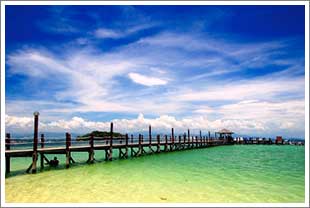
A good variety of marine life can be spotted on the sandy seabed, including scorpion fish, blue-spotted rays, cuttlefish, mantis shrimps and the occasional green or hawksbill turtle. At some locations, rare creatures such as the harlequin ghost pipefish and mandarin fish may be found with the help of a dive guide.
From November to February, plankton blooms attract krill, which in turn attracts whale sharks, the world’s largest fish. At times, the density of the krill can be so thick that in such murky conditions, underwater encounters with these colossal creatures as they appear out of the gloom are unforgettable.
Mataking Island
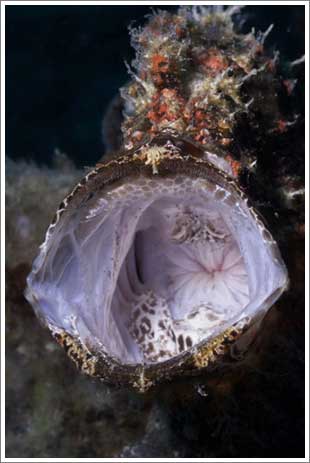
The island of Mataking is home to a sprawling, deluxe dive resort complete with spa and open-air Jacuzzi. It is, like the famous Sipadan, reached via the east coast town of Semporna, although it is located northeast rather than south.
Diving around Mataking and the nearby islands is a contrasting combination of macro and pelagic life, making it suitable for both novice and advanced divers, particularly photographers. The eastern shore of the island is a gently sloping reef, bottoming out at around 100m, while on the other side, it is mostly wall diving down the western reef which rises about 100m from the Sulawesi Sea.
The colourful corals of Mataking are a haven for many species of nudibranch and frogfish, other marine life includes humphead parrotfish, rainbow runners, bat fish, barracuda, blue-spotted rays, giant clams, mantis shrimps, lobsters and both green and hawksbill turtles.
Each of the dive sites on the islands near Mataking offers its own wonders in terms of marine life. On Mataking itself, a range of activities to entertain non-divers make a stay in this well landscaped resort a pleasure for all.
Mabul Island
Its proximity to Pulau Sipadan (about 5 minutes away by boat) was the initial draw card of Mabul, although it soon became apparent that it offered excellent muck diving which some claim is among the world’s best. There are several dive resorts on the island, as well as an offshore ex-oil rig offering accommodation.
A small flat island with sandy beaches, Mabul sits on the northwest corner of a 200-hectare reef. On its sandy bottoms, on the coral reefs and around man-made ‘reefs’, Mabul offers an astonishing array of small marine life.
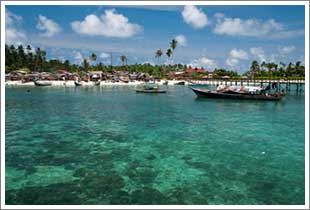
Flamboyant cuttlefish, blue-ringed octopus, mmic octopus and bobtail squid are just a few of the cephalopods to be found on Mabul’s reef. Harlequin shrimp feeding on sea stars, and boxer crabs waving theit tiny arms are just a small sample of the endless species of crustaceans. Many types of goby can be found, including the spike-fin goby, black sail-fin goby and metallic shrimp goby.
Frogfish – giant, painted and clown – are everywhere and moray eels and snake eels can be seen along with almost the entire scorpion fish family, while the brilliantly coloured little mandarin fish can be seen doing their mating dance at dusk. Mabul is truly a magical macro site.
Kapalai
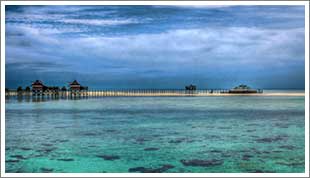
Rising like a mirage out of the Sulawesi Sea, the Sipadan-Kapalai Dive Resorts sits on top of part of the Ligatan Reefs, about 15 minutes from Pulau Sipadan. A tiny crescent of sand visible at low tide is all that remains of what was once Kapalai Island before erosion took its toll.
Styled like a traditional water village, the dive resort combines simplicity with tasteful comfort.
All its wood and thatch chalets perched over the sea with verandahs that make it possible to gaze down at lion fish or even turtles without having to don a snorkel.
Diving here, together with trips to nearby Mabul offers some of the world’s best muck diving. Rare creatures such as flamboyant cuttlefish, blue-ringed octopus, sea moths and mating mandarin fish are regularly seen, as are giant frogfish, ribbon eels, harlequin ghost pipe fish and crab-eye gobies.
The jetty dive at the resort itself has plenty to offer, including leaf scorpion fish, pink-eye gobies, ammonium shrimps and the mantis shrimp, lightning-fast as it grabs its prey. Crocodile fish, lion fish and scorpion fish are so common as to be taken for granted.
Tun Sakaran Marine Park
The Tun Sakaran Marine Park off Semporna is Sabah’s newest and largest Marine Park. Gazetted in 2004 to protect the area’s spectacular fatures and rich biodiversity, it comprises 8 islands and over 100km of reef.
It is also the only marine protected area in Sabah to include private land and have a resident population who rely on the marine resources for their livelihood.
Seaweed farming and fishing (with a permit) are the main occupations of the community, although alternative livelihoods including eco-tourism are being investigated.
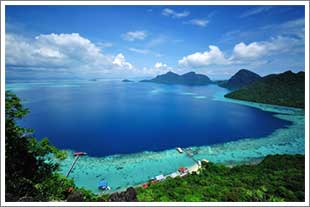
The central islands are part of an extinct volcano with peaks reaching 450m above sea level and the crater has become a lagoon, now inundated by the sea. The low lying outer islands are a complete contrast with beautiful white sand beaches and coconut palms.
Fringing reefs encircle each of the 8 islands and there are also two patch reefs (Church Reef and Kapikan/Tabbah Kumai) and one bank reef (Mantabuan Bank). The reefs are great for critter hunting however the Park is also a refuge for 7 species of giant clam (Tridacnidae), including the critically endangered T.gigas which can reach over 1m in length.
The park is under the management of Sabah Parks and visitors are required to register at the Sabah Parks office in Semporna or via their tour agent. There is currently no overnight accommodation in the Tun Sakaran Marine Park but there are a number of dive companies based in Semporna running daily diving to the park.
Sipadan
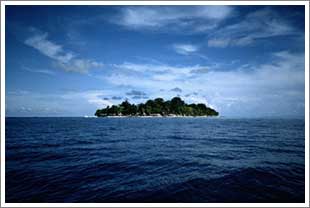
One of the top dive sites in the world, Sipadan lies in the Sulawesi Sea just 5 degrees north of the equator, off the southeast coast of Sabah.
The island is reached via the town of Semporna, about 45 minutes away by boat. Sipadan is thickly forested (and home to a number of interesting birds), and surrounded by sandy white beaches.
An oceanic island formed by corals growing on top of an extinct undersea volcano, Sipadan rises 600m up from the ocean floor. To say that the wall diving here is spectacular is an understatement.
Sipadan is in the heart of the Indo-Pacific basin, the richest marine habitat in the world, where more than 3000 species of fish and hundreds of coral species have been classified.
Sipadan is renowned for its unusually large number of green and hawksbill turtles coming to mate and nest, it is not unusual to see more than 20 turtles on a single dive. Residential schooling barracuda and big-eye trevally, which often gather in their thousands, create spectacular tornado-like formations, one of the highlights of every diver’s wish list. There is also the possibility of seeing pelagic species such as eagle rays, mantas, hammerhead sharks and whale sharks.
A unique feature at Sipadan is the ‘turtle tomb’, an underwater labyrinth of caves and tunnels that contain the skeletal remains of many turtles which became disoriented and drowned.
The macro life at Sipadan is as amazing as the big fish, with garden eels, leaf scorpion fish, mantis shrimps, fire gobies and various pipefish guaranteed at certain dive sites. With its diversity and abundance of marine life, it is little wonder that Sipadan is acclaimed worldwide.
Since 2005, dive resorts that had been operating on Sipadan were closed to help conserve both marine and land eco-systems, and divers are brought in by boat from resorts on nearby islands by their dive operator. In 2009, Sabah Parks, which manages the island, opened attractive wooden facilities for day visitors.

